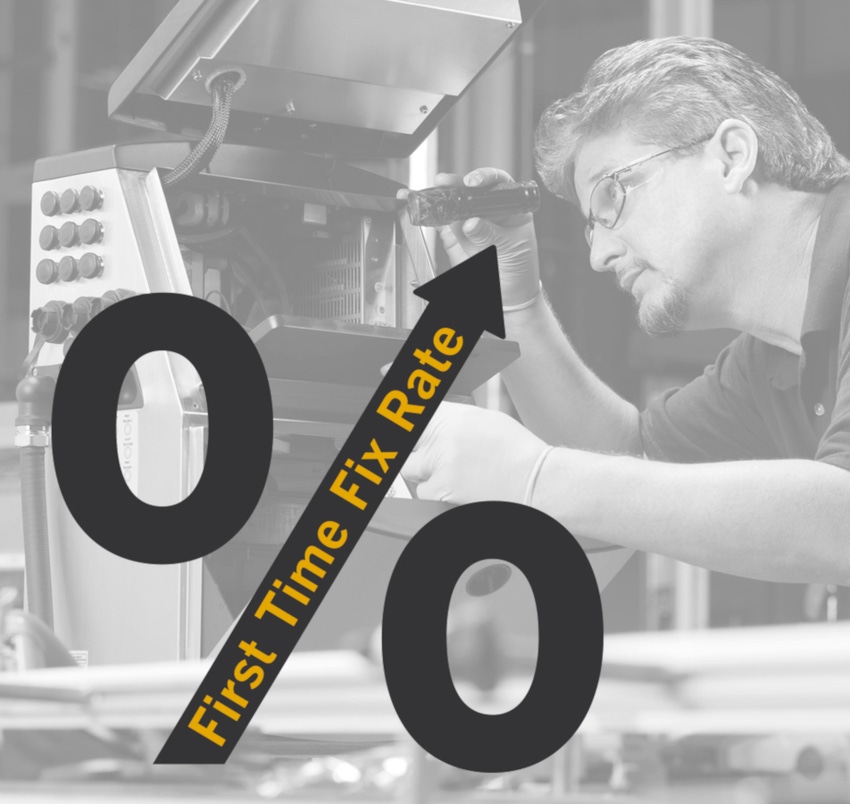
An increasing ability to directly access printer data, modular equipment design and growing predictive maintenance are steadily improving First Time Fix Rates.
The term First Time Fix Rate (FTFR) indicates the percentage of the time that a system manufacturer is able to correct a customer’s equipment issue on the first visit, without the need for a return visit after obtaining additional expertise, information or parts. For a company with a downed label printer or coding system that is holding up production, the ability of a supplier to solve the problem quickly is a primary driver of customer satisfaction. As a result, FTFR is an important measurement of the quality of an equipment manufacturer’s service capability, which can in turn be a strong selling point for the company’s systems.
First Time Fix Rates are only calculated for site visits by the manufacturer’s technicians, but in recent years, the frequency of required visits has been trending downward as a direct result of increasing online capabilities. First, service personnel are better able to quickly and correctly diagnose and resolve problems remotely. Second, the access to direct input from the printer software can better prepare a technician for a site visit by detailing the problem and the replacement parts that will be needed. This means the technician is not arriving to face a problem, but with the solution in hand.
Assessment
Every repair begins with an assessment of the problem. The customer’s line operator calls the equipment manufacturer’s service line to report a problem, and the manufacturer gathers details about the problem either during that initial request for service call or from a pre-call by the service engineer assigned to the work order. The technical information acquired prior to going on site is essential to correcting the problem—and correcting it quickly.
Depending on what the conversation reveals, the manufacturer may be able to walk the customer through correcting the problem over the phone. However, if the technician concludes that the problem is more complex, and a site visit by a repair technician is required, it will be scheduled.
This is typically how service has worked in the past, when many systems operated independently of each other. Today, however, most online equipment incorporates digital control software and is connected to both the local line management system and often to the cloud/internet. As this level of connectivity becomes more prevalent, when that first call comes in, the technician is increasingly able to respond by directly accessing the equipment software to assess the problem.
This lets the technician see the software error messages and related data, including the history of the equipment’s recent performance. Rather than relying on a line supervisor to describe what they perceive to be wrong, the technician can analyze the relevant data directly. This speeds up and improves the assessment process while eliminating misleading communication errors.
Corrective action
The ability to take corrective action is also evolving. In reviewing the printer’s software data, the technician may see that resolving the problem won’t require replacing a part. In that case, the customer may be able to get the printer up and running with the technician walking line personnel through the solution. This is the quickest way to getting the line up and running and doesn’t require a site visit.
Even if the technician can’t help the customer fix its problem immediately, the information gathered by accessing the printer remotely will make the subsequent site visit more efficient, making a first time fix more likely. The problem assessment has already been done and the needed parts identified.
The ability to take corrective action quickly has also evolved as the design of equipment has evolved. The most recent printers are modular structures, making repairs much simpler to make. When a printer’s valve, for example, is malfunctioning, what in the past would have required an onsite repair visit may today simply involve replacing the valve module. Newer printers, with more advanced user interfaces, can even display detailed preventive maintenance instructions that aid in optimizing performance and reducing downtime. Many larger customers, who typically favor the advantage of this new technology, are also likely to inventory replacement modules.
Not every company has the latest model printer, however, and repairs—including replacing parts—will still have to be made in many cases. In these cases, it is essential that the technician making a service call have all available information and potential parts needed on hand.
Even with the most advanced equipment and connectivity, corrective action is still a cooperative effort. Whether the customer has the most recent model printer, capable of being assessed in detail via the cloud, or an older version, the customer’s team plays an essential role in the success of the repair. It is essential that a new model printer remains continuously connected to the cloud, and that the connection is reset after a power failure or other interruption, or essential data will not be captured. When an older printer fails, whoever calls the service line needs to be standing at the printer, able to answer the technician’s questions and relay error messages.
The future of First Time Fix Rates
There are multiple reasons why FTFR rates today are steadily improving. As the next level of service—predictive maintenance—becomes more widespread, will FTFR cease to be an important metric?
The basis of predictive maintenance is that, as all systems become connected to the cloud, their status is continuously and automatically monitored. Alerts are sent to customer and manufacturer service teams as they approach, but have not yet reached, the point of failure. Replacement parts can move to a more Just-in-Time delivery method. Software updates can be made remotely and the need for site visits is consequently greatly reduced, if not eliminated.
There will always be a veteran printer somewhere needing hands-on attention by a skilled technician. FTFR will continue to be a valuable way to evaluate a manufacturer’s service for all of its equipment and for all of its customers. Meanwhile, the ability to access data from downed systems and the growth of predictive maintenance are having a significant effect on FTFR. Not only are repairs being made more quickly in each facility, but technicians are then able to reach the next customer’s repair more quickly. Service for all customers is being improved, and the benefit is increased productivity for all.
____________________________________________________________________________________________
MinnPack 2019 (Oct. 23-24; Minneapolis) is where serious packaging professionals find technologies, education and connections needed to thrive in today’s advanced manufacturing community. See solutions in labeling, food packaging, package design and beyond. Attend free expert-led sessions at multiple theaters around the expo.
About the Author(s)
You May Also Like




